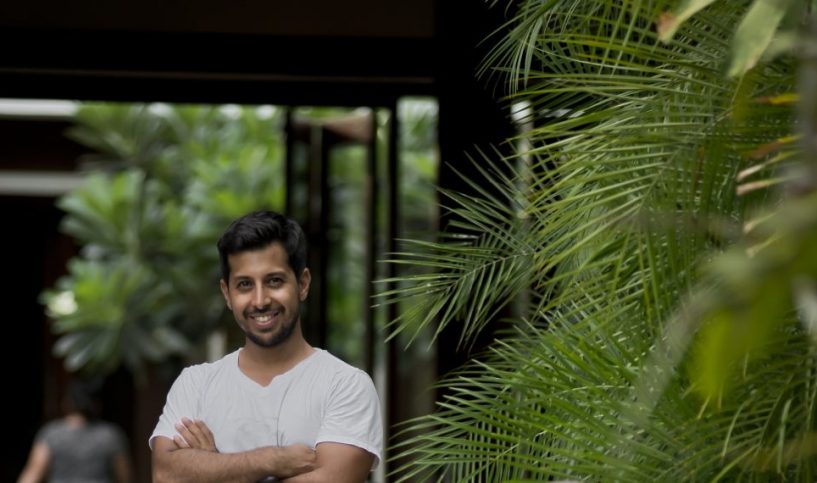In 2012, we met Aziz AlHumaidhi as Principal in Charge at NHE Consultants. Since then, the local architect has graduated from working for his father’s Engineering Consultancy, learning the tricks of the trade to move towards building greater aspirations for himself in the form of AlHumaidhi Architects: a practice specializing in a modern approach to building structures in Kuwait.
Upon indulging on the “Projects” page of AlHumaidhi Architects’ website, you can easily see the influence of Aziz’s passion for architecture in the works he envisioned and implemented. Whether the project is commercial or residential, Aziz’s vision includes the generous use of glass to invite floods of light, as well as clean lines and the theme of geometric patterns. It boasts the craft of an artist who thoughtfully constructs spaces to make the most out of embracing the gifts that have to offer, such as sunlight, temperature, and lots of shade for Kuwait’s extreme heat in the summer and rainfall in the winter. After all, these are factors every architect has to consider, as theirs is a practice that marries many of life’s greatest skills: a penchant for math, science, logic and drawing.
With a keenness to learn more, we chat with Aziz, touching on the exciting journey of building his dream further, from when he was a fortressing child, to his very first project, to the inception of the empire he is building for himself today.
How did your journey with architecture begin?
I suppose I explored the urge of human nature to find or create and utilize shelter from an early age. I enjoyed creating enclosures and fortresses to inhabit. I would sleep in them and move through tents and tunnels attached to one another like an obstacle course. I also drew as a child and continued to draw all throughout high school. When it came time to apply for university, I tried to think of a degree that would combine my interests in drawing and art with other forms of study, such as science mathematics and physics. I felt that architecture offered the best of both worlds, and decided to apply to the Rhode Island School of Design, where I graduated with a degree in architecture as well as a degree in fine arts.
What prompted you to build your practice?
Our practice was established prior to my granting by my civil engineer father, who I worked for since 2002 [at NHE Consultants]. At around 2008, I began to manage more of the office’s functions, and a couple of years later, I became the head of office and have since been directing it towards a more architectural and design-based practice than an engineering one.
What’s the most challenging aspect of being an architect?
For me, the most challenging aspect is the all-encompassing nature of design and the slow turnover of each project. Design takes time and so does execution, meaning one’s learning curve is quite shallow. This is why, I suppose, it is called an “architectural practice: you have to practice over and over with each project in order to better understand the multiple factors and elements that influence design. You have to not only conceptualize and visualize a design, but be able to figure out every small detail, construction specification and its impact on the specific element it’s covered with. You also have to be mindful of the general overview of the project as a whole.
What is your signature architectural “style” if you have one, or any influences you look up to?
My style is pragmatic, and some may see it as modern due to its lack of ornamentation or classical elements. I try to create spaces and designs that work for their intended use, and to fulfill the client’s brief, first and foremost. Then, there are factors like budget, maintenance, location, users and constructability that influence every decision made towards the final design. And even after completing said design, sometimes during construction a lot of items may change and adapt to a myriad of factors: from contractor issues and owner changes, to economic factors and/or miscellaneous issues. The challenge is adapting all these changing and unfolding obstacles, and how to use them to our advantage rather than resisting. We allow life and its circumstances to be a factor in determining the final look and feel and contraction of the project. It’s not about forcing one’s own vision on a project, but rather being the artistic and/or technical facilitator of the vision behind it in the face of the circumstances that govern it now and later.
What are some of the most memorable projects you’ve worked on?
My first project is probably my most memorable one. I was asked to design a memorial commemorating the deaths of young students at a local school due to car accidents. The project was my first experience with a budget, a brief, and a site. The brief was emotionally charged: I felt a connection to it since I too, suffered from the loss of a relative in a car accident not long before this. I was given a small site with a pre-existing, mature, palm tree, which the client wanted to uproot in order to make room for the memorial. In conceptualizing the project, the idea was to resist the initial intention to remove the tree and rather keep it and enshrine it in a glass enclosure with the names of those deceased etched on the glass. The tree became the backdrop to this monument, and continued to grow and thrive as with the memory of those who passed away. The location was within an existing playground, so children would see it daily to be constantly reminded of the memorial’s representation. The opening was very beautiful and emotional to the parents, and it gave me a taste into what impact architecture and design could have on people.
What is your opinion on the future of architecture in the region? How do you feel it’s changing in Kuwait?
Many young, talented architects are emerging in the country, and I’m happy to see them grow and expand their client base and project base. I think that in order to fully develop the profession, we must focus on demystifying the architectural profession and the design process to the layman. Only when they understand how we work and how much effort is involved in the process, will the profession be truly accepted for what it really is.
Visit AlHumaidhi Architects’ website at: www.alhumaidhiarchitects.com, and follow them on Instagram @alhumaidhiarch.










